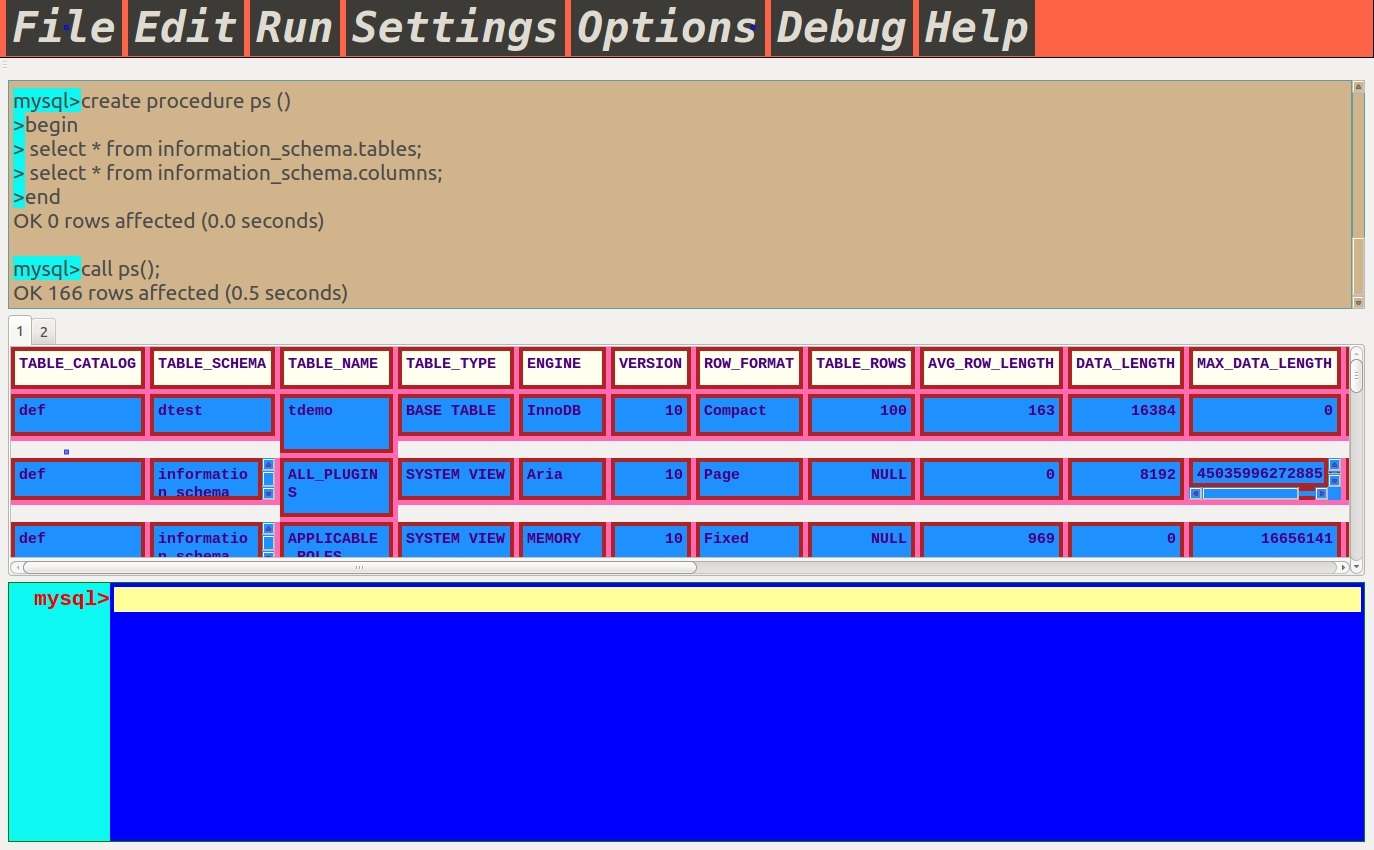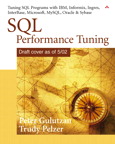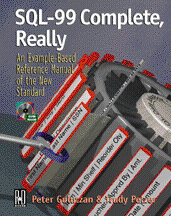
Company Info
Download
Peter Gulutzan's blog
screenshots
Books by employees
Glossary
Home

Books By Ocelot Employees
Summary
by Peter Gulutzan and Trudy Pelzer (click to see Amazon user reviews):
SQL Performance Tuning
 A book by Peter Gulutzan and Trudy Pelzer, published by Addison-Wesley in September 2002.
Advice and explanation about what affects database performance, based on
experience and testing with eight SQL DBMSs (DB2, Informix, Ingres, InterBase,
Microsoft, MySQL, Oracle, Sybase). Example topics: what syntax is faster,
how indexes work, when to use stored procedures, where bottlenecks can happen.
A book by Peter Gulutzan and Trudy Pelzer, published by Addison-Wesley in September 2002.
Advice and explanation about what affects database performance, based on
experience and testing with eight SQL DBMSs (DB2, Informix, Ingres, InterBase,
Microsoft, MySQL, Oracle, Sybase). Example topics: what syntax is faster,
how indexes work, when to use stored procedures, where bottlenecks can happen.
Reviews
Check the review at The Association of C and C++ Users ACCU Book Review site. Reviewer Christopher Hill says: "This should not be your first book on SQL, but every DBA and SQL writer should have a copy to hand. Highly recommended."
Check the review at Microsoft Certified Professional Magazine. Reviewer David W. Tschanz calls SQL Performance Tuning an "instant classic".
Check the review at sql-server-performance.com. This well-known site says: "If you are in any way involved as a DBA or developer who uses SQL in their job, this book is a must addition to your library"!
Check the review by Craig Mullins (author of several DB2 and database administration books), who says: "This book provides a comprehensive overview of SQL performance tuning giving guidance and advice on how to properly code and tune SQL for the major DBMS products ... . Very useful and well written." Later Mr Mullins added: "The first SQL book I recommend is SQL Performance Tuning by Peter Gulutzan and Trudy Pelzer."
Check the review at Java Ranch. This reviewer says: "Every SQL expert wishes they had had this book when they started. It would have saved them years of frustration. ... Buy this book now."
Check the review at eWEEK. Gulutzan and Pelzer did a "wonderful job" says reviewer Peter MacIntyre.
Notice the short answer that PHP expert Lukas Smith gives in answer to an interviewer's request for a book recommendation: "I know SQL is not hip these days, but SQL Performance Tuning by Peter Gulutzan and Trudy Pelzer was probably the most important book for my career. I learned so much, which gave me the confidence to really step up and from there I was able to grow my knowledge in every direction I needed to go."
Earlier Gulutzan/Pelzer books got favourable reviews from industry experts
like Jeff Duntemann and Joe Celko. Readers of the last book (SQL-99 COMPLETE, REALLY)
put these comments on amazon.com:
"The only book I'd recommend"
"A truly superb reference book"
"Best manual I've read in years"
The publisher (Addison-Wesley) sent pre-publication copies of SQL PERFORMANCE TUNING to some well-known authors, DBAs, and instructors. Here are quotes from their technical reviews:
Click here for errata and information that became available after we went to print.
Table Of Contents
CHAPTER 1 / Facilis Descensus Averni
This Subject Is Important ... The Big Eight ... Installation Parameters ... Test Results ... Portability ... Terminology and Expectations ... Conventions ... Generalities
CHAPTER 2 / Simple Searches
General Tuning ... Code for Points ... Constant Propagation ... Dead Code Elimination ... Ensure You use the Right DBMS ... Constant Folding ... Case-insensitive Searches ... Sargability ... The Bottom Line: General Tuning ... Specific Tuning ... AND ... OR ... AND Plus OR ... NOT ... IN ... LIKE ... SIMILAR ... UNION ... EXCEPT ... INTERSECT ... CASE ... The Bottom Line: Specific Tuning ... Style Notes ... Parting Shots
CHAPTER 3 / ORDER BY
General Sort Considerations ... The ORDER BY clause ... To Sort or not to Sort ... The Bottom Line: General Sorts ... Character Sorts ... Character Sort Support ... Collations ... The Bottom Line: Character Sorts ... Other Options ... Sort Keys ... Encouraging Index Use ... Pre-Ordering ... The Bottom Line: Other Options ... Parting Shots
CHAPTER 4 / GROUP BY
Refresher ... Optimal GROUP BY clauses ... HAVING ... Alternatives to GROUP BY ... The Bottom Line: Optimal GROUP BY clauses ... Sorting ... Indexes ... The Bottom Line: Sorting ... Set Functions and Summary Aggregates ... COUNT ... SUM trouble ... Multiple Aggregation Levels ... Expressions ... The Bottom Line: Aggregates ... Parting Shots
CHAPTER 5 / Joins
Join Plan Strategies ... Nested-loop Joins ... The Bottom Line: Nested-loop join plans ... Sort-merge Joins ... The Bottom Line: Sort-merge join plans ... Hash Joins ... The Bottom Line: Hash join plans ... Avoid the Join Strategies ... Join Indexes ... Composite Tables ... The Bottom Line: Avoiding joins ... 3-way Joins and Beyond ... Old Style versus ANSI Style ... Outer Joins ... Parting Shots
CHAPTER 6 / Subqueries
Refresher ... Join versus Subquery ... Flattening ... The Bottom Line: Join versus Subquery ... Syntax Choices ... IN ... DISTINCT ... EXISTS ... IN or EXISTS? ... Double INs ... TOP ... > ALL ... Set Operations ... The Bottom Line: Syntax Choices ... Parting Shots
CHAPTER 7 / Columns
How Big Is The Size Factor? ... Fixed or Variable? ... The Bottom Line: The Size Factor ... Characters ... Length Specification ... Variant Character sets ... The Bottom Line: Characters ... Temporals ... The Bottom Line: Temporals ... Numbers ... Integers ... Floats ... Decimals ... Serials ... The Bottom Line: Numbers ... Bits ... The Bottom Line: Bits ... Large Objects ... The Bottom Line: LOBs ... NULLs ... The Bottom Line: NULLs ... Column Order Within Rows ... The Bottom Line: Column Order ... Parting Shots
CHAPTER 8 / Tables
The Storage Hierarchy ... Pages ... LOB Pages ... Extents ... Read Groups ... Files ... Partitions ... Tablespaces ... The Bottom Line: Storage Hierarchy ... Heaps ... ROWID ... Migration ... Fragmentation ... Free Page Space ... The Bottom Line: Heaps ... Clusters ... The Bottom Line: Clusters ... The Normal Forms ... Breaking Normalization Rules ... The Bottom Line: Normalization ... Views ... The Bottom Line: Views ... Parting Shots
CHAPTER 9 / Indexes
Refresher ... B-trees ... Searching a B-tree ... Inserting into a B-tree
... Deleting from a B-tree ... Fragmentation ... Rebuilding a B-tree
... The Bottom Line: B-trees ... Types of Indexes ... Compound Indexes
... Covering Indexes ... Unique Indexes ... Clustered Indexes ... Strong Clustered Indexes
... Choice of Clustered Key ... Secondary Indexes to a Strong Clustered Index
... The Bottom Line: Types of Indexes ... Bitmap Indexes ... The Bottom Line: Bitmap Indexes
... Other Index Variations ... Index Key Values ... The Bottom Line: Index Key Values
... Parting Shots
CHAPTER 10 / Constraints
NOT NULL ... NULL Indicators ... The Bottom Line: NOT NULL Constraints
... CHECK ... The Bottom Line: CHECK Constraints ... FOREIGN KEY
... The Bottom Line: FOREIGN KEY Constraints ... PRIMARY KEY
... The Bottom Line: PRIMARY KEY Constraints ... UNIQUE
... The Bottom Line: UNIQUE Constraints ... Triggers
... The Bottom Line: Triggers ... Disabling Constraints ... Defer ... Disable ... Drop
... The Bottom Line: Disabling Constraints ... Client Validations
... The Bottom Line: Client Validations ... Redundant SELECT clauses
... The Bottom Line: Redundant SELECTs ... Parting Shots
CHAPTER 11 / Stored Procedures
Refresher ... Determinism ... Advantages of Stored Procedures
... Less Traffic ... Semi-Precompilation ... Parameters ... Other Tips
... The Bottom Line: Stored Procedures ... Parting Shots
CHAPTER 12 / ODBC
Refresher ... Tracing MS-Query ... SQLPrepare ... The Bottom Line: SQLPrepare
... Fetch Loops ... The Bottom Line: Fetch Loops ... Data Change Statements
... The Bottom Line: Data Change Statements ... Catalog Functions
... The Bottom Line: Catalog Functions ... Parting Shots
CHAPTER 13 / JDBC
Connections ... Connection Pooling ... Connection Settings
... Auto-commit ... Isolation Level ... Connections and DBMS Info
... The Bottom Line: Connections ... Query Prepping ... Query Statement
... Query Syntax ... getBestRowIdentifier ... ResultSetMetaData ... Query Settings
... Scroll Type ... Concurrency Type ... FetchSize ... The Bottom Line: Query Prepping
... Result Sets ... How Many Rows? ... getXXX methods ... Impedance ... Close
... The Bottom Line: Result Sets ... Data Changes ... The Bottom Line: Data Changes
... Parting Shots
CHAPTER 14 / Data Changes
Logs ... The Bottom Line: Logs ... INSERT ... Bulk INSERT ... The Bottom Line: INSERT
... UPDATE ... Dependent UPDATE ... Batch UPDATE ... The Bottom Line: UPDATE
... DELETE ... The Bottom Line: DELETE ... Ugly Updates
... The Bottom Line: Ugly Updates ... FETCH & Data Changes
... The Bottom Line: FETCH & Data Changes ... COMMIT & ROLLBACK
... The Bottom Line: COMMIT & ROLLBACK ... Parting Shots
CHAPTER 15 / Locks
What is a Lock? ... Lock Modes ... Granularity ... Escalation ... Intent locks
... The Bottom Line: Locks ... Isolation Levels ... Concurrency Problems and Isolation Levels
... READ UNCOMMITTED Transactions ... READ COMMITTED Transactions
... REPEATABLE READ Transactions ... SERIALIZABLE Transactions
... READ ONLY or FOR UPDATE ... Deadlocks ... The Bottom Line: Isolation Levels
... Index Locks ... The Bottom Line: Index Locks ... Hot Spots
... The Bottom Line: Hot Spots ... Optimistic Locking ... The Bottom Line: Optimistic Locking
... The Scan Trick ... Parting Shots
CHAPTER 16 / Clients and Servers
Middleware ... The Bottom Line: Middleware ... Server Processes & Threads
... Separateness and Parallelism ... The Bottom Line: Server Processes & Threads
... What should the Client do? ... Bottom Line: Client Tips ... Parting Shots
CHAPTER 17 / Cost-Based Optimizers
Cost ... Statistics & Histograms ... Analyzing Statistics ... EXPLAIN
... Hints ... Parting Shots
Appendixes
Glossary ... Further Reading
SQL Performance Tuning was DB2 Magazine's "Featured Title" for November 2002.

HOW TO ORDER
You can call your local bookstore. Tell them
the title is "SQL Performance Tuning"; the authors are "Peter Gulutzan & Trudy Pelzer";
the publisher is "Addison-Wesley"; and the ISBN is "0-201-79169-2".
You can order from the publisher. To order
multiple copies or ask about textbook pricing,
go to Addison-Wesley's site.
You can order from amazon.
SQL-99 Complete, Really
 The standard reference book for SQL-99 (formerly known as SQL3).
The standard reference book for SQL-99 (formerly known as SQL3).
GENERAL BOOK INFO . Size 1078 pages plus about 400 on the
accompanying CD-ROM.
CHAPTER HEADINGS:
Introduction, General Concepts,
Numbers, Bit Strings, Binary Strings, Characters, Character Strings,
Temporal Values, Boolean Values, Collection Types, Row Types, Reference
Types, NULLs, SQL Clusters, AuthorizationIDs, SQL Catalogs, SQL Schemas,
SQL Tables and Views, SQL Domains, SQL Constraints and Assertions,
SQL Character Sets, SQL Collations, SQL Translations, SQL Triggers,
SQL-Invoked Routines, PSM, User-Defined Types, Introduction to SQL-Data
Operations, Simple Search Conditions, Searching With Joins, Searching
With Subqueries, Searching With Set Operators, Searching With Groups,
Sorting Search Results, Changing SQL-Data, SQL Transactions, SQL
Transaction Concurrency, SQL Sessions, Embedded SQL Binding Style,
SQL/CLI Binding Style, SQL/CLI: env Functions, SQL/CLI: SQL/CLI: dbc
Functions, SQL/CLI: stmt Functions, SQL/CLI Statement Functions,
SQL/CLI: Cursor Functions, SQL/CLI: desc Functions, SQL/CLI Diagnostic
Functions, SQL/CLI: General Functions, SQL/CLI Deferred Parameter
Functions, SQL/CLI Locator Functions, SQL/CLI Catalog Functions,
Module Binding Style, Style, Remote Database Access, SQL Taxonomy,
Non-Portable SQL Features, Incompatibilities with SQL-92, SQL Web Sites,
Glossary.
The CD-ROM includes a sample DBMS.
Title = "SQL-99 Complete, Really";
Authors = "Peter Gulutzan & Trudy Pelzer";
Year = "1999";
Publisher = "CMP Books";
ISBN = "0-87930-568-1"
But Amazon will only have used copies of the printed edition. which is a better bet.
Copyright (c) 2002-2013 by Ocelot Computer Services Inc. All rights reserved.
Peter Gulutzan is also the author of
Descriptive SQL Style Guide
Send enquiries or suggestions to help@ocelot.ca.